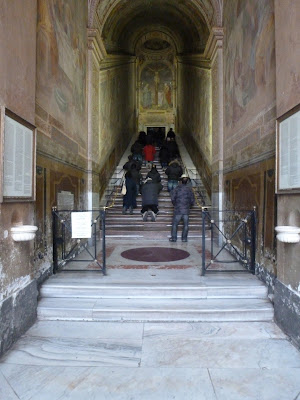Today I had my second on-site class for Roman Catholicism. We visited some of the most important churches in Rome which housed some very cool relics. Our first stop was San Giovanni in Laterano:
San Giovanni is the cathedral church of Rome, and the official
ecclesiastical seat of the Bishop of Rome (aka the Pope). The church
oficially belongs to Vatican City, so when you enter it you are
technically in another country. It is the oldest and ranks first
among the four major basillicas of Rome. It was constructed in the
early 300s after Emporer Constantine signed the Edict of Toleration
granting Christians the freedom to practice their religion. It was
built close to the outside walls of the ancient city (which are still
standing today) in an effort to not offend all those still practicing
paganism.
 |
| Reliquary containing the skulls of St. Peter and St. Paul. |
 |
| Largest Obelisk in Rome. Over 3000 years old. |
 |
| These doors are over 2000 years old and were taken from a building
in the Roman Forum. |
Behind San Giovanni is another small church housing the Sancta
Scala or Holy Stairs. These were reputedly brought to Rome by Emperor Constantin's mother St. Helena in the 4
th century. They
are supposedly the the steps that led up to the praetorium of Pontius
Pilate in Jerusalem, where Jesus Christ was tried and found guilty.
Even at 9:30 in the morning devout Christians can be seen climbing
the steps on their knees as a sign of penance. Martin Luther was
alleged to have climbed these steps on his knees as well as a few
popes.
This is Santa Croce in Gerusalemme. It houses a few other relics St. Helena brought back with her from the Holy Land (see pics below). One of the coolest facts about this place is that when St. Helena was attempting to bring relics back to Rome she was told that the relics must always remain on Holy Soil. How did she solve this problem? The church is built on three boats of dirt from the Jerusalem... hence the name.
 |
| From rt. to left, and top to bottom: panel which was hung on Christ's Cross (generally either ignored by scholars or considered to be a medieval forgery.); two thorns of the crown; a nail; three small wooden pieces of the cross itself, and the finger of doubting Thomas (which he supposedly stuck through Jesus' wounds when he rose from the dead). |
 |
| Shroud that had touched Jesus' face... if I remember correctly... |
The last church- Santa Maria Maggiore:
 |
| Relic from Jesus' manger. |

















